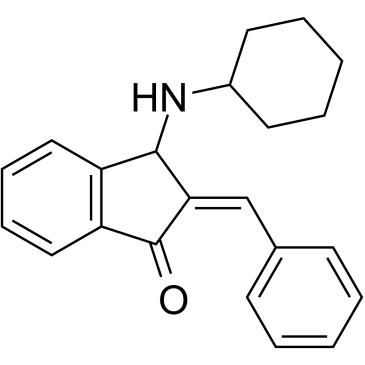| Cas No.: | 15982-84-0 |
| Synonyms: | NSC 150117;NSC-150117;NSC150117 |
| SMILES: | O=C1C2C=CC=CC=2C(NC2CCCCC2)/C/1=C/C1C=CC=CC=1 |
| Formula: | C22H23NO |
| M.Wt: | 317.424125909805 |
| Purity: | >98% |
| Sotrage: | 2 years -20°C Powder, 2 weeks 4°C in DMSO, 6 months -80°C in DMSO |
| Publication: | [1]. Zhang F, et al. DUSP6 Inhibitor (E/Z)-BCI Hydrochloride Attenuates Lipopolysaccharide-Induced Inflammatory Responses in Murine Macrophage Cells via Activating the Nrf2 Signaling Axis and Inhibiting the NF-κB Pathway. Inflammation. 2019 Apr;42(2):672-681. [2]. Wu QN,et al. Pharmacological inhibition of DUSP6 suppresses gastric cancer growth and metastasis and overcomes cisplatin resistance. Cancer Lett. 2018 Jan 1;412:243-255. |
| Description: | (E/Z)-BCI (NSC 150117) is a dual-specificity phosphatase 6 (DUSP6) inhibitor with anti-inflammatory activities. (E/Z)-BCI attenuates LPS-induced inflammatory mediators and ROS production in macrophage cells via activating the Nrf2 signaling axis and inhibiting the NF-κB pathway[1]. |
| Target: | DUSP6[1] |
| In Vivo: | (E/Z)-BCI hydrochloride (35 mg/kg; intraperitoneal injection; every 7 days; for four weeks; female BALB/c nude mice) treatment enhances cisplatin efficacy in PDX models[2]. Animal Model: Patient-derived xenograft (PDX) models (4-5-week-old female BALB/c nude mice)[2] Dosage: 35 mg/kg Administration: Intraperitoneal injection; every 7 days; for four weeks Result: Tumor weights in the PDX models treated plus CDDP were significantly suppressed compared with tumors from PDX model mice treated with either agent alone. |
| In Vitro: | (E/Z)-BCI hydrochloride (2-10 μM; 72 hours) significantly decreases cell viability in a time and dose-dependent manner in gastric epithelial cell GES1, GC cell lines, and AGS cell lines[2]. (E/Z)-BCI hydrochloride (0.5-4 μM; 24 hours) significantly inhibits DUSP6 expression in LPS-activated macrophages[1]. (E/Z)-BCI hydrochloride (0.5-2 μM; 24 hours) treatment significantly inhibits the expression of IL-1β, TNF-α and IL-6 mRNA in LPS-activated macrophages[1]. (E/Z)-BCI hydrochloride decreases ROS production and activates the Nrf2 pathway in LPS-activated macrophages[1].(E/Z)-BCI hydrochloride inhibits cell proliferation, migration and invasion in a receptor-independent manner and enhances Cisplatin (CDDP) cytotoxicity (enhances CDDP-induced cell death and apoptosis) at pharmacological concentrations in the gastric cancer (GC) cells[2]. Cell Viability Assay[2] Cell Line: Gastric epithelial cell GES1, GC cell lines (HGC27, SGC7901, MKN45, BGC823, MGC803, SNU216, NUGC4), AGS cell lines Concentration: 2 μM, 4 μM, 6 μM, 8 μM, 10 μM Incubation Time: 72 hours Result: Cell viability was significantly decreased in a time and dose-dependent manner. Western Blot Analysis[1] Cell Line: RAW264.7 macrophage cells (by LPS-activated macrophages) Concentration: 0.5 μM, 1 μM, 2 μM, 4 μM Incubation Time: 24 hours Result: DUSP6 protein was significantly downregulated in LPS-activated macrophages. RT-PCR[1] Cell Line: RAW264.7 macrophage cells (by LPS-activated macrophages) Concentration: 0.5 μM, 1 μM, 2 μM Incubation Time: 24 hours Result: The expression of IL-1β, TNF-α and IL-6 mRNA was significantly inhibited inLPS-activated macrophages. |
| References: | [1]. Zhang F, et al. DUSP6 Inhibitor (E/Z)-BCI Hydrochloride Attenuates Lipopolysaccharide-Induced Inflammatory Responses in Murine Macrophage Cells via Activating the Nrf2 Signaling Axis and Inhibiting the NF-κB Pathway. Inflammation. 2019 Apr;42(2):672-681. [2]. Wu QN,et al. Pharmacological inhibition of DUSP6 suppresses gastric cancer growth and metastasis and overcomes cisplatin resistance. Cancer Lett. 2018 Jan 1;412:243-255. |

 DC Chemicals' products qualify for U.S. tariff exemptions. We guarantee no price increases due to customs duties and maintain stable supply, continuing to deliver reliable research solutions to our American clients.
DC Chemicals' products qualify for U.S. tariff exemptions. We guarantee no price increases due to customs duties and maintain stable supply, continuing to deliver reliable research solutions to our American clients.





















